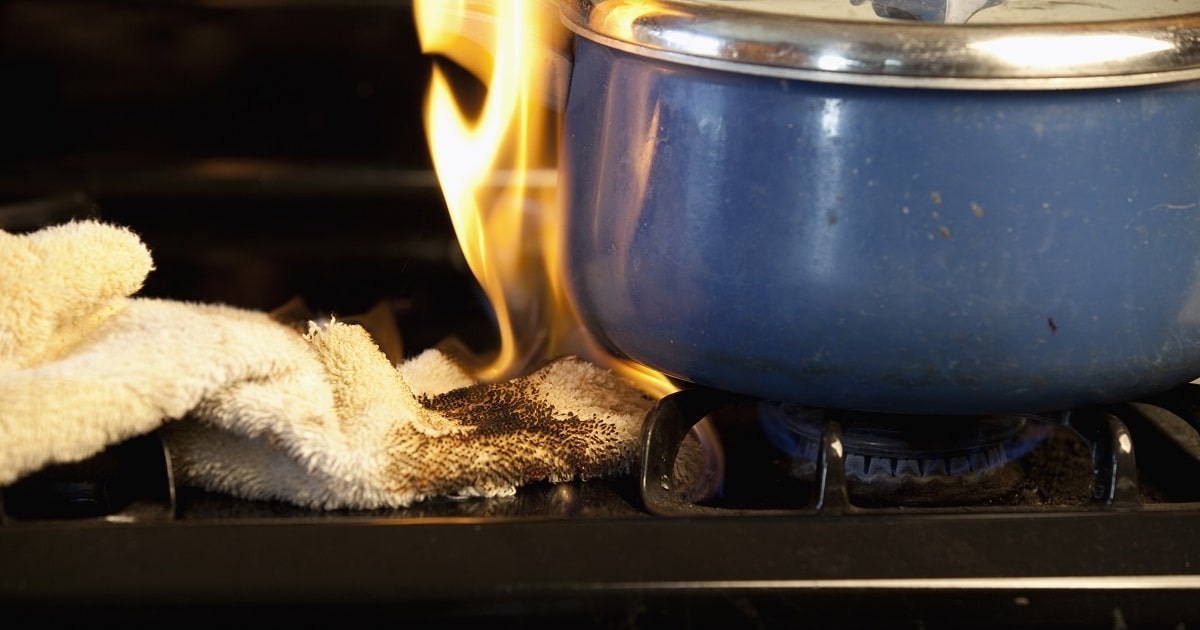Summary: Unattended cooking is the leading cause of home fires and fire injuries in the United States. The NFPA’s Fire Prevention Week 2021 takes place October 3-9 with the goal of spreading fire safety tips to help reduce the amount of home fires. Learn more about this important awareness event. Over a hundred years ago, the Chicago Fire of 1871 burned through the city and beyond. Also known as the Great Chicago Fire, it destroyed thousands of buildings, caused an estimated $200 million in damages, resulted in over 250 deaths and left thousands of people homeless. The fire raged for two days, from October 8 through 10, when rain finally assisted firefighters in their efforts to put out the flames. In the years following the fire, the Windy City’s new mayor promised to enforce stricter building and fire codes as reconstruction efforts continued.
Fire Prevention Week, sponsored by the
National Fire Protection Association (NFPA), is held every year during the week of October 9 in memory of the Great Chicago Fire. President Calvin Coolidge proclaimed the week a national observance in 1925, making it the longest-running public health observance in the United States.
What is the Purpose of National Fire Prevention Week?

As the official sponsor of National Fire Prevention Week for more than 90 years, the NFPA educates the public about the simple things they can do to prevent fires in their homes. The theme for 2021 is “
Learn the Sounds of Fire Safety.” The campaign helps educate everyone about the different sounds smoke and
carbon monoxide alarms make and knowing what to do when the alarm sounds to keep your family safe.
There are smoke alarms and other devices for people who are deaf or hard of hearing by using flashing strobe lights that alert people when the smoke alarm sounds.
The NFPA details the difference in sounds between the carbon monoxide and smoke alarms in the
campaign fact sheet:
- Smoke alarms have a continued set of three loud beeps signaling a fire
- Carbon monoxide alarms have a continuous set of four loud beeps when carbon monoxide is present
- A single chirp every 30-60 seconds signals the battery is low on a smoke or carbon monoxide alarm and must be changed
- Smoke alarms should be changed every ten years
- Check the manufacturer’s information for a carbon monoxide alarm length of use
The goal of Fire Prevention Week 2021 is to ensure that if you hear either the three or the four beeps from your alarm devices, it is critical to get out of the home and call 911.
Fire Prevention Tips for the Kitchen
Homes are not the only ones at high risk for a fire. Small businesses can suffer a fire’s devastation for a variety of reasons, including
electrical fires to
commercial kitchens fires. The NFPA recommends keeping the following fire prevention tips in mind to help reduce home fires and fire injuries:
Cook with caution
Stay in the kitchen near the stove whenever cooking, frying, broiling or grilling food. Never leave a hot stove unattended, even for a short amount of time. Also, keep items that could catch fire clear of the stove, such as towels, oven mitts, wooden utensils and food packaging. Remember, the leading cause of home fires is unattended cooking in the kitchen.

Know how to handle a grease fire
Throwing water on a grease fire will only escalate the situation. Instead, smother the fire using the lid of the pan, and then turn off the burner. If the grease fire occurs in the oven rather than the stovetop, turn off the heat and keep the oven door closed. Most fires in the home are due to the kitchen stove.
Install smoke alarms
When it comes to fires, a properly installed, working smoke alarm can mean the difference between life and death. The NFPA reports that smoke alarms reduce the risk of dying in a home fire by half. Smoke alarms should not only be installed in kitchens, but in every room, in every level of the house, including the basement. Test them often, and use the change of seasons as a reminder to swap out the batteries for fresh ones.
Have a home fire escape plan
Finally, every resident in the home should know how to get out in the event of a fire. The fire escape plan should include a map of the home, detailing exits like windows and doors, so everyone knows of at least two ways to get out. Practice the plan a few times throughout the year to keep it fresh in everyone’s mind.
Loss Control Services from AmTrust Financial
AmTrust Financial’s
Loss Control department understands that knowledge is key to safety. A few of our top
business classes include restaurants, retail stores and more recently, apartment buildings and complexes. We provide a variety of
industry resources, plus the expertise and tools our policyholders need to reduce risk. For more information about our loss control capabilities, please
contact us today.
 This material is for informational purposes only and is not legal or business advice. Neither AmTrust Financial Services, Inc. nor any of its subsidiaries or affiliates represents or warrants that the information contained herein is appropriate or suitable for any specific business or legal purpose. Readers seeking resolution of specific questions should consult their business and/or legal advisors. Coverages may vary by location. Contact your local RSM for more information.
This material is for informational purposes only and is not legal or business advice. Neither AmTrust Financial Services, Inc. nor any of its subsidiaries or affiliates represents or warrants that the information contained herein is appropriate or suitable for any specific business or legal purpose. Readers seeking resolution of specific questions should consult their business and/or legal advisors. Coverages may vary by location. Contact your local RSM for more information.